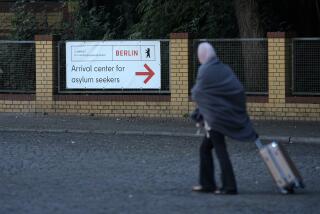Hamburg Was Hub for Emigration From Eastern Europe to the West
- Share via
HAMBURG, Germany — The opening this year of the National Museum of Immigration at Ellis Island in New York harbor brackets neatly with the Historic Emigration Office in Hamburg, the port city of Northern Germany about 60 miles from the North Sea on the Elbe River.
If one’s ancestors originated in Germany, Poland, Russia or other countries of Eastern Europe, and they emigrated to America between 1850 and 1934, chances are they came through Hamburg.
And for those interested in tracing their ancestors through Hamburg, there’s a good chance the Museum of Hamburg History, which is part of the Historic Emigration Office, can come up with the facts.
The museum can work from old letters, birth certificates, a family Bible, perhaps, or any detail from which records can be traced. After receiving the emigration year of the ancestors and $30, it will undertake research that may result in an ancestors’ age, their occupation, marital status, number of children and the city where they came from, as well as the name of the ship on which they sailed and the date the ship left for the New World.
And all of the information will be embossed on a certificate that can be framed.
Hamburg’s distinct position, as a kind of crossroads port city in Northern Germany, made it a prime transit point for emigrants crossing from Eastern to Western Europe and the United States.
In those days, the city required every ship company to issue listings of passengers with their names, age, occupation and home city. As a result, the museum can offer this service today.
Today’s travelers who want to trace their ancestors can whisk into Hamburg nonstop from Newark, N.J., in seven hours. From Los Angeles, travelers must fly to Frankfurt, transfer and take a 40-minute flight to Hamburg.
Yet traveling to the place that may have been a temporary home to your ancestors is not just a journey of family significance. The city itself is fascinating.
Hamburg’s enormous port, covering 56 square miles of waterways and warehouses, is still filled with everything from Soviet freighters to sea containers.
The port handles the world’s largest trade in Persian carpets, importing some $1 billion worth every year.
It also imports huge amounts of newsprint, for Hamburg is also the publishing capital of Germany.
On Sundays, the Fischmarkt becomes not just a place to buy fish. It attracts clowns, mimes, jugglers and suppliers of all sorts of goods.
Although Hamburg likes to call itself a “green city”--indeed, residential areas are banded with belts of green--it is crossed by 40 miles of canals and has more bridges than any other city, Venice included.
A city of contrasts, the one-time home of Johannes Brahms is also home to the Reeperbahn, one of the most notorious night spots in the world. There, the signs blare out “World of Sex,” “Super Video Peep Show,” “Sex Life Show” and “Sexy Eye-Land,” all in the same neighborhood where “Cats” is still playing.
Sailboats, windsurfers, canoes and sculls fill the Alster River in summer, but motorboats are not allowed. When the waters freeze over in winter, hot dog stands and brewers of hot chocolate open for business on the ice.
The best residences face the water and so do some of the better hotels, among them the Atlantic Hotel Kempinski on one side of the water and Hotel Vier Jahreszeiten on the other.
The Kempinski has been remodeled, but the Vier Jahreszeiten, often ranked among the world’s best, still has more than a dozen tiny shabby single rooms and still wants for a pool. Its new Japanese owners may fix that. Some old single rooms rent for $177 a night, and those with a terrace over the lake go for more than $200 a night. Doubles run to $300 a night.
Conventioneers are more likely to book at the 500-room SAS Plaza, a skyscraper that is tacked onto the enormous Congress Center.
Here the singles are $200, doubles $240, with breakfast included. Pool, bar, express laundry and well-equipped offices available for a day make it ideal for the business traveler. And the Hamburg Marriott Hotel is midtown and handy to other stores.
This is the city of Brahms and a modernistic sculpture honoring him is derisively referred to as the “Black Noodles.”
St. Michael’s, or “St. Mike’s” as it is called, is an enormous baroque church, with 6,600 organ pipes, holding free recitals at noon every day. The music is stirring. So is the church, with its enormous marble pulpit topped by gilded angels stretching to the edge of the pews.
If hunger strikes, the ancient Galerie Stuben dispenses nourishment from its “original Hamburger Kuche” around the corner at Krayenkamp No. 11.
Hamburg has more pedestrian malls than any city on the Continent, if that is considered an achievement. No-car walkways and escalators that go up or down only when you step on them make shopping a pleasure.
In this city of 1.6 million souls, 50,000 are students at Hamburg University. Also, there are 18 McDonald’s. What would you expect in a city called Hamburg?
More to Read
Sign up for The Wild
We’ll help you find the best places to hike, bike and run, as well as the perfect silent spots for meditation and yoga.
You may occasionally receive promotional content from the Los Angeles Times.





